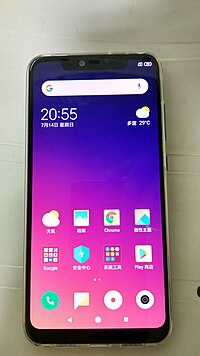Xiaomi Mi 8
 | |
| Codename | dipper |
|---|---|
| Manufacturer | Xiaomi |
| Series | Mi |
| First released | May 2018 |
| Units sold | 1 million (as of June 23, 2018[update])[1] |
| Predecessor | Xiaomi Mi 6 |
| Successor | Xiaomi Mi 9 |
| Related | Pocophone F1 |
| Type | Touchscreen smartphone |
| Form factor | Slate |
| Dimensions |
|
| Mass | 175 g (6.2 oz)
|
| Operating system | MIUI 12 based on Android 10 |
| System-on-chip | Qualcomm SDM845 Snapdragon 845 |
| CPU | Octa-core (4x 2.8 GHz Performance Kryo 385 Gold cores + 4x 1.8 GHz efficiency Kryo 385 Silver cores) |
| GPU | Adreno 630 |
| Memory | 6 GB LPDDR4X RAM |
| Storage | 64 GB/128 GB |
| Battery | Non-removable Li-Po 3400 mAh battery |
| Display | 6.21 inches, 1080 x 2248 pixels, (402 ppi), SUPER AMOLED touchscreen, 16M colors HDR10 DCI-P3 |
| Rear camera | Dual: 12 MP (f/1.8, 1/2.55", 1.4µm, 4-axis OIS, dual-pixel PDAF) + 12 MP (f/2.4, 1/3.4", 1.0µm), 2x optical zoom, dual pixel phase detection autofocus, dual-LED flash |
| Front camera | 20 MP (f/2.0, 1.8µm), 1080p |
| Connectivity | 2G, 3G, 4G, 4G LTE, Wi-Fi 802.11a/b/g/n/ac (2.4 & 5GHz), dual-band, WiFi Direct, DLNA, hotspot Bluetooth V5, A2DP, Low-energy, aptX HD |
| Data inputs | Dual band GNSS (GPS/GLONASS/BeiDou/Galileo) |
The Xiaomi Mi 8[2] is a flagship Android smartphone developed by Xiaomi Inc. It was launched at an event held in Shenzhen, China[3] as the successor to the Xiaomi Mi 6. The naming of the Xiaomi Mi 8 (skipping the Mi 7) is in celebration of Xiaomi Inc's eighth anniversary.[4] The Mi 8 draws parallels to the iPhone X, as both the rear and front of the phone are replicated.[5] This design was later carried on to the mid-range Redmi Note 6 Pro and Mi A2 Lite.
Specifications[edit]
Hardware[edit]
The Xiaomi Mi 8 is powered by the Qualcomm Snapdragon 845 processor, with 6 GB LPDDR4X RAM and Adreno 630 GPU. It has a 6.21-inch (158 mm) FullHD plus AMOLED display. Storage options include 64 GB or 128 GB. The handset features a fingerprint scanner on the rear or on the screen under the display, in the Explorer Edition.[6] It features a 3,400 mAh battery with a USB-C reversible connector which supports Quick Charge 4.0+. It has Gorilla Glass 5. It does not feature a 3.5mm headphone jack and comes with a USB-C to 3.5mm headphone jack adapter provided in the box. The Mi 8 includes a dual camera setup with a 12 MP wide angle lens sensor and a 12 MP telephoto lens sensor. The front camera has a 20 MP sensor with an aperture of f/2.0. The Mi 8 camera has an overall score of 99 and a photo score of 105 on DxOMark.[7] Explorer Edition also introduces a 3D optical facial recognition with the standard IR Sensor for dark condition[8] and a dual band GNSS which allows reception of L1 and L5 signals simultaneously.
Software[edit]
It runs on Android 10, with Xiaomi's custom MIUI 11 skin which is upgradeable to MIUI 12.
References[edit]
- ^ "Xiaomi sells over 1 million Mi 8 series phones in less than three weeks". GSMArena. Retrieved June 25, 2018.
- ^ "Xiaomi Mi 8 Specifications". GSMArena. Retrieved 2018-06-04.
- ^ "Xiaomi's Mi 8, Mi 8 Explorer Edition and Mi 8 SE officially launched in China". Business Today. Retrieved 2018-06-04.
- ^ Black, Marie (15 July 2018). "Xiaomi Mi 8 Review - TechAdvisor". techadvisor.co.uk. Retrieved 3 October 2018.
- ^ Lovejoy, Ben (31 May 2018). "Apple clone-maker Xiaomi's new Mi 8 closely mimics the iPhone X". 9to5mac.com. Retrieved 3 October 2018.
- ^ "Xiaomi Mi 8 vale à pena comprar?". Celulares Chineses (in Portuguese).
- ^ Xiaomi Mi 8 camera review: Challenging the best - DxOMark
- ^ "Xiaomi Mi8 Vs Explorer Edition Vs Mi 8 SE". AndroidLeo. 11 February 2020.
